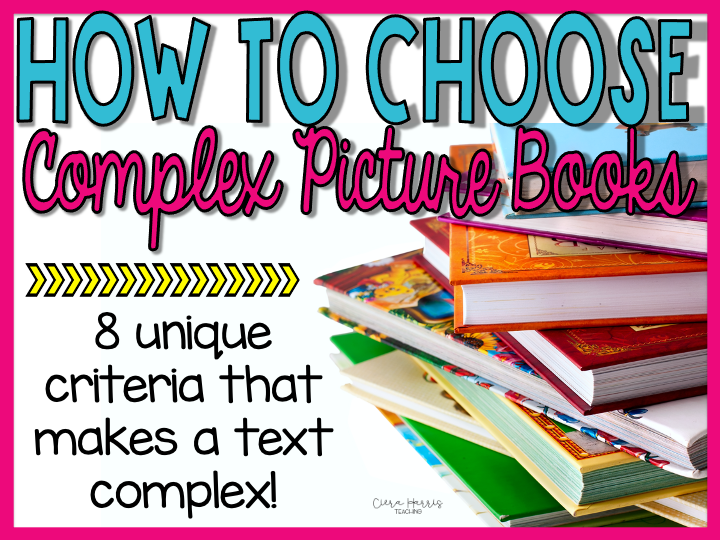There are so many picture books out there! So, how do you know which one is the right one? Trust me- I’ve been there! It is hard to decide with so many options. Thankfully, the Science of Reading shows teachers that we must select complex picture books for upper elementary. When we become very conscious of how to choose complex books, students can dive in deeper and think critically about what they are reading. Since deciding what makes a book complex is tricky, let’s dive into 8 aspects that will help you select picture books for upper elementary.
Want to watch the video instead? Check it out below! Make sure to subscribe to get updates on all new content!
Using Picture Books for Teaching
Picture books are a fantastic way to teach reading skills and strategies. However, it is important to focus on how to choose complex books to ensure students are using their brains. When there are complex picture books for upper elementary, students can build their knowledge, skills, and reasoning with the help of their teacher. Students will be successful in learning the standards with the right selections!
Ways to Analyze Picture Books
When learning to choose complex books, there is a lot to remember. The book must be right for you, your students, and what you need them to do. So, let’s explore 8 lenses to use when selecting picture books for upper elementary.
Multiple Layers of Meaning
If the book is genuinely complex, it will typically have multiple layers of meaning to explore. This encourages students to dive deeper into the text and illustrations. If there is nothing deeper, they can’t do this. Therefore, they cannot apply different skills and strategies. So, a book needs to have a deeper layer of meaning. It cannot just be a basic surface layer text.
Rich Vocabulary
If you do not have the “Dolores Thesaurus,” I highly recommend you get one!
When learning to choose complex books, it is essential to consider how it will enhance students’ vocabulary. The vocabulary is a key indicator of whether or not the book is complex. If students know every single word, then it is probably not complex enough for students to do the thinking you want. You want picture books for upper elementary with diverse, rich vocabulary to build the language skills of students.
Varied Perspectives
This is key for open-ended conversations and lots of different takeaways! You want to find books that have varied perspectives. It is particularly helpful when characters and settings bring in those perspectives. This helps spark discussions on different cultures, experiences, and viewpoints.
Be sure to check out For the Right to Learn Character Perspective lesson!
Symbolism and Metaphors
Yes, figurative language has to be on the list when exploring how to choose complex books. Ensuring books include figurative language is a fantastic way to bring out layers. This is because they help students think beyond the literal level. Students must go past and find deeper meanings embedded in the text and illustrations.
Complex Characters and Themes
When selecting picture books for upper elementary, it is vital to select ones with characters that have multiple layers. This means they go through different emotions, have many motives, and undergo change and growth. Additionally, multiple perspectives help add in themes and connections for students. Ultimately, this helps students identify morals and lessons they can apply outside of the book. This is a fantastic way to help students think about the world around them!
Be sure to check out The Book of Gold Theme Lesson for a fantastic resource!
Open-Ended Questions
When learning how to choose complex books, it is vital to add more thinking. So, look for picture books for upper elementary that allow open-ended questions for students. If the book does not do this, it is clearly a no.
Illustrations as Text
This is big! Students of all ages love picture books. Looking for illustrations as text is a great way to help build the complexity. This allows students to look at the illustrations and see what the illustrator shows that the author doesn’t say.
Cultural Relevances
It is vital to select books that resonate with the cultural backgrounds and experiences of your students. This creates meaning and tons of personal connections. Additionally, it promotes deeper engagement and allows students to know everyone sees and respects them. This even allows students to gain great insight into their culture or different cultures, which naturally connects to open-ended questions.
Be sure to check out The Day You Begin Making Connections for an amazing story and lesson!
Learning how to choose complex books may take a bit of work, but it will be well worth it! When using these 8 lenses, teachers will know their picture books for upper elementary challenge, support, and scaffold students. Honestly, so much rich learning will occur when using books that meet these aspects!
If you do not want to miss any of the upcoming lessons, join my email list to be notified of all the interactive lessons coming up! By joining the email list, you will receive freebies for blog exclusive subscribers!










